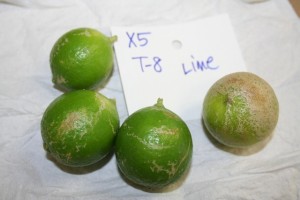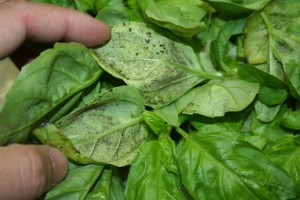On the 2nd day of 2012, things at the Plant Clinic are slowing getting back into a regular routine. Today, we also added a new person to our staff. Molly Giesbrecht came on board as our Extension Assistant with primary duties in coordinating the plant disease survey projects that we will be conducting this year. In addition, she will be also helping out with the various project that we have going on in the Clinic.

Lime samples to be tested for the presence of the Sweet Orange Scab pathogen.
This time last year, we were working with Citrus specifically looking for sweet orange scab – a disease caused by the fungus Elsinoe australis. Then soon after, we started to see some downy mildew on basil. This was the uncommon basil disease that did occur the previous year. Around this time, I also got to work on some Palm Lethal Decline (aka Phoenix Palm Decline) which is caused by a phytoplasma. In 2011, conditions were dry all over. The hard drought put a bunch of stress on many different types of plant. A large number of our sample come from urban areas. We saw landscape plants and trees that were exhibiting drought stress for a large portion of 2011. We had quite a few of specimen that came in with root rots which we suspect was due to stressed plant and overwatering (from our visceral reaction to the drought). We also answered lots of phone calls and emails from folks that were wondering why their plants were not doing well. Around August, we started getting calls and samples of roses with the dreaded Rose Rosette syndrome. This disease caused by a virus where once it gets into the plant, there is no remediation.

Sign of downy mildew on genovese basil plants.
Last year was also a year which brought on some budgetary issue. Cuts to both the State and Federal budget resulted in major evaluation of how we can continue to provide a quality service while meeting our mission to support our AgriLife Extension personnel and to better the lives of the people in Texas and beyond. 2011 saw a rise in the routine diagnostic fees, going from $30 to $35, and an addition of a out-of-state surcharge of $20 per sample. The Federal budget cut to the National Plant Diagnostic Network fund mean less funding for personnel at the Plant Clinic. Grass root efforts continue to help ensure that there will be funds that will be committed to safe-keeping the food and plant materials of the United States through this networks of diagnostic clinics for rapid detection and response, as well as an educational outlet to the general public to be on the look out for these potential invaders.
2011 was an interesting year with the extra dry conditions and the severe budget strains. I look forward to a better and perhaps more prosperous 2012. Wishing all a Happy New Year and may it be a prosperous one for you.


